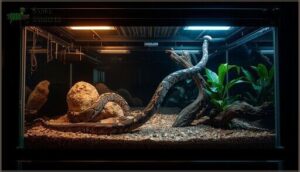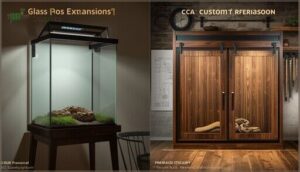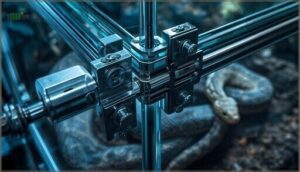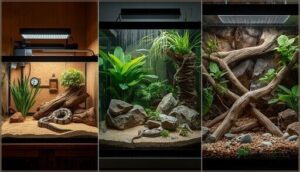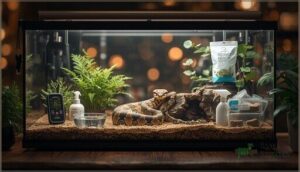This site is supported by our readers. We may earn a commission, at no cost to you, if you purchase through links.

Essential accessories such as hides, water bowls, and climbing branches add to the mix, and ongoing expenses like food, vet care, and equipment replacements should be factored in.
Whether you’re customizing a palace for a ball python or securing a fortress for a boa, it all adds up. Knowing the lay of the land from the start makes your cold-blooded companion’s adjustment smooth as silk.
Table Of Contents
- Key Takeaways
- Snake Habitat Setup Cost Breakdown
- Choosing The Right Snake Enclosure
- Essential Heating and Lighting Solutions
- Selecting Suitable Substrate and Accessories
- Species-Specific Habitat Requirements
- Ongoing Snake Care and Maintenance Costs
- Top 10 Snake Habitat Products for 2024
- 1. Mini Reptile Snake Hat Accessories Set
- 2. Mini Pet Hats Cute Animal Decor
- 3. Adjustable Snake Crown for Ball Python
- 4. Zilla Shed Ease Reptile Bath
- 5. Pet Lou Green Jungle Snake Toy
- 6. Zoo Med Aspen Snake Bedding
- 7. Sphynx Cat Summer Snake Shirt
- 8. Bearded Dragon Cowboy Hat Bandana Set
- 9. ECOFLEX Mojave 36 Inch Reptile Lounge
- 10. Simple Deluxe Ceramic Heat Emitter
- Frequently Asked Questions (FAQs)
- How do you choose a snake enclosure?
- How often should snake habitat decor be replaced?
- How much does a snake vet cost?
- How do I create a safe home for my scaly snake?
- How do you care for a snake’s enclosure?
- How do I get started taking care of snakes?
- How much does snake habitat insurance cost?
- What are costs for pest prevention in enclosures?
- How expensive is to relocate a large setup?
- Are there added fees for exotic snake permits?
- Conclusion
Key Takeaways
- Initial setup costs for a snake habitat vary widely based on enclosure type, heating, lighting, substrate, and essential accessories, with budget-friendly DIY options and pricier custom solutions available.
- Heating and lighting systems, along with thermostats, are crucial for your snake’s safety and health, and their ongoing energy costs depend on your regional rates and how much equipment you use.
- Ongoing expenses—including food, bedding, equipment replacement, and vet care—quickly add up and should be factored into your long-term budget from the start.
- Each species has unique needs for space, security, humidity, and enrichment, so tailoring your habitat setup is key to keeping your snake healthy and stress-free.
Snake Habitat Setup Cost Breakdown
Setting up the right habitat is the first key step in keeping your snake healthy and secure.
Let’s take a look at what you’ll need to get started—and what you can expect to spend up front.
Tank and Enclosure Costs
Shopping for a snake enclosure is a bit like picking out your first apartment—you want the right size, the right price, and a home where your new roommate can actually thrive.
- Tank size impact: Larger habitats mean higher habitat setup costs.
- Enclosure material costs: Glass, PVC, or wood all affect your budget.
- DIY enclosure savings and used tank market: Both can seriously stretch your dollar.
Heating Systems and Thermostats
Once you’ve found the perfect place for your snake to settle in, it’s time to make sure the temperature’s just right with the right heating gear and a reliable thermostat.
Different heating types—like mats, lamps, or emitters—let you create a temperature gradient.
Thermostat safety isn’t negotiable; it cuts risks, saves energy, and matches your species’ needs, keeping costs in check.
Substrate, Hides, and Water Bowls
After you’ve dialed in the warmth, it’s time to make your snake’s world cozy with the right bedding, a snug hideout, and a sturdy water bowl.
- Choose substrate types prioritizing substrate safety and easy cleaning frequency.
- Pick hides made from safe, secure hide materials for enrichment value.
- Opt for a water bowl size that’s stable, easy to refill, and resists spills.
Decorations, Plants, and Enrichment
Your snake’s space becomes more than just functional once you add branches, plants, and a few clever touches that spark natural behaviors. Climbing structures and safe plants boost enrichment benefits, letting your snake explore, hide, and move like it would in the wild.
A naturalistic design with varied hides and environmental enrichment features costs $50–$100, though affordable snake accessories can trim that budget. Providing enrichment features transforms tank decorations into tools for your pet’s well-being.
DIY Vs. Store-Bought Solutions
Building your own enclosure usually costs $150–$200 in materials for a standard 4×2×2 setup, while store-bought PVC options run $342–$417. DIY solutions offer customization options and material sourcing flexibility, but labor investment averages 8–12 hours. Store-bought habitats save time yet limit size choices.
DIY durability matches commercial builds when done right, keeping long-term costs and habitat setup quality comparable for your snake habitat setup. For example, a 4x2x2 melamine tank can cost around $110 fully complete with glass and vents.
Cost of Purchasing a Snake
Before you even think about tanks and thermostats, you’ll need to budget for the snake itself—and prices swing wildly depending on the species you choose. Common species like ball pythons start around $50–$100, but rare morphs can hit $500 or more.
Ethical sourcing matters—reputable breeders charge fair prices and guarantee healthy animals, making your initial investment worthwhile for long-term snake ownership success.
Choosing The Right Snake Enclosure
Choosing the right enclosure comes down to size, how secure it feels, and what you want to spend. Let’s walk through the main choices and what sets them apart.
Selecting Optimal Tank Dimensions
Choosing the right tank size isn’t just about fitting your snake inside—it’s about giving them room to stretch, explore, and actually live, not just survive.
When selecting suitable tank dimensions for your snake enclosure, aim for floor space that’s at least 1.5 times your snake’s adult length. You’ll also need coiling space and enclosure height that matches your species’ activity level—arboreal snakes climb, terrestrial snakes roam.
Custom Vs. Pre-Made Enclosures
Pre-made enclosures run $160–$400 for standard sizes, ready to use within days. Custom builds cost $400–$800 or more, but you get exact dimensions for species adaptability, premium material quality like thick HDPE or marine plywood, and features adapted to humidity or ventilation needs. Custom durability often exceeds 20 years versus 6–10 for basic pre-mades. The Essential 4 enclosure is one such option designed for medium-sized reptiles.
Market trends show 48% of experienced keepers prefer custom options despite higher habitat setup cost, while 82% of newcomers choose affordable pre-mades for immediate snake habitat setup.
Stackable and Modular Options
If you’re planning to house more than one snake—or just want breathing room as your collection grows—stackable and modular systems can turn a single footprint into a vertical reptile tower. These expandable habitats boost space efficiency, cutting your floor space by 60–70% compared to side-by-side enclosures.
Modular designs offer customization options—add another level when you’re ready, adapting to your future proofing needs without rebuilding from scratch. While initial habitat setup cost runs $500–$900 for three-tier systems, you’ll see cost savings long-term versus buying separate enclosures.
Many keepers combine store-bought racks with DIY solutions to balance budget and function.
Escape-Proof Locks and Security Features
Snakes are escape artists by nature—a fact that turns a small gap or weak latch into a one-way ticket to freedom (and a frantic search under your couch).
Invest in locking mechanisms rated for reptile use—standard cage clips won’t cut it. Check glass thickness and secure ventilation grilles for gaps wider than your snake’s head.
Many DIY solutions add barrel bolts for emergency access without compromising enclosure design integrity.
Essential Heating and Lighting Solutions
Your snake won’t thrive without the right temperature, and getting that balance costs less than you might think.
Let’s break down heating mats, lamps, ceramic emitters, and the thermostats that keep everything safe—plus what you’ll actually spend on electricity each month.
Types of Heating Systems (Mats, Lamps, Emitters)
When you’re setting up your snake’s heating, you’ll choose between three main systems. Heat mats sit beneath the tank and work well for floor-dwelling species, though heat mat safety requires careful monitoring.
Ceramic heat emitters screw into lamp fixtures and provide infrared heat without light—ideal for maintaining nighttime temperatures with impressive ceramic heat lifespans of 5+ years.
Basking lamps offer visible warmth using specific basking lamp wattage matched to your enclosure size, while infrared emitter benefits include gentle, penetrating heat that mimics natural warmth without disturbing your snake’s day-night cycle.
Thermostat Regulation and Safety
No heating system works safely without a thermostat watching the temperature—think of it as your snake’s insurance policy against burns and cold snaps.
Quality thermostats cost $20–$213 and include emergency shutoff features to prevent overheating. You’ll need proper probe placement near your heat source and a separate thermometer to verify your temperature gradient.
Thermostat calibration ensures accurate readings, while temperature alarms alert you to dangerous fluctuations before your snake gets hurt.
Calculating Ongoing Energy Costs
Your heating systems and thermostat regulation work together, but monthly utilities depend on wattage and runtime. Use the energy cost formula: (Total Watts × Hours per Day ÷ 1000) × Rate per kWh = Daily Heating Cost. A 100W heat lamp plus 20W UV lamp running 12 hours costs roughly $5 monthly at $0.12/kWh.
Thermostat savings cut runtime by 40%, while insulation efficiency prevents heat loss.
Regional rate impact matters—UK owners pay nearly double U.S. rates, and lighting wattage impact varies by heating solutions chosen.
Lighting Needs for Different Species
Not every snake needs the same light show—diurnal species rely on UVB for calcium metabolism, while nocturnal pythons thrive with simple day-night cycles and no special bulbs required.
Corn snakes appreciate basking spots under heat lamps with 12-hour light cycles, whereas ball pythons skip UV lighting entirely.
If you’re adding live plants, expect higher lighting costs. Budget $20–$50 yearly for bulb replacements, separate from heating mats and general heating costs.
Selecting Suitable Substrate and Accessories
Once you’ve got the right enclosure and heating dialed in, it’s time to think about what goes inside.
Next up, let’s dig into choosing the right substrate, picking out the must-have accessories, and finding that sweet spot between quality and what you want to spend.
Comparing Substrate Types and Costs
Choosing the right substrate isn’t just about grabbing the cheapest bag at the pet store—it’s about balancing your snake’s health needs with what makes sense for your wallet and cleaning schedule.
Aspen shavings ($5-$15) offer excellent odor control and cleaning ease but won’t hold humidity for tropical species. Cypress mulch ($10-$20) provides enhanced humidity retention and substrate safety, though it requires more frequent replacement.
Paper towels or reptile carpet ($5-$30) excel in cleaning ease and visual appeal while letting you monitor health closely, making substrate selection a practical decision based on your specific snake’s requirements.
Water Bowls, Hides, and Climbing Branches
Your snake’s furniture—sturdy water bowls, secure hiding spots, and textured branches—transforms a glass box into a functional home that meets both survival needs and natural behaviors.
Water bowl size matters: your snake should fit completely inside for soaking during sheds. Hide material safety ensures no sharp edges, while branch species suitability depends on whether you’re housing terrestrial or arboreal snakes.
- Water bowls ($15-$25): Choose heavy ceramic or weighted plastic to prevent spills in the enclosure
- Hides ($30-$50): Budget for at least two—one on the warm side, one cool—to let your snake thermoregulate comfortably
- Climbing branches ($20-$40): Natural wood offers enrichment benefits and climbing space needs, especially for semi-arboreal species
These snake accessories form your habitat’s foundation, not optional extras.
Backgrounds, Rocks, and Enrichment Features
Think of enrichment features as the difference between a storage unit and a living space—they turn sterile glass into an environment that engages your snake’s senses and encourages natural exploration.
Background aesthetics ($15-$40) create depth perception while providing enrichment benefits, and climbing features like textured rocks ($10-$30) encourage movement. Rock safety matters—avoid sharp edges.
If your snake likes to burrow, make sure there are spots for digging—it’s not just about looks; accessories should give your snake something real to do.
Accessory Expenses and Budget Options
Ever wonder how far a little creativity—plus a thrifty mindset—can stretch your snake habitat budget?
Sourcing DIY accessories, scouring used marketplaces, and grabbing discount bundles during seasonal sales makes cost-effective snake care doable.
Essential snake accessories, from hides to water bowls, show up at every price point. With thoughtful planning, affordable snake accessories and budget snake ownership are well within reach.
Species-Specific Habitat Requirements
Different snake species each have their own unique housing needs—everything from how much space they require to the type of enclosure they’ll be happiest in.
Here’s a rundown of what to keep in mind when setting up space for different types of snakes.
Ball Python, Boa Constrictor, and Burmese Python Needs
From the gentle nature of a Ball Python to the massive appetite of a Burmese, big names in the snake world all come with their own wish lists for a happy, healthy home.
- Ball Pythons thrive in moderate enclosure size, with precise humidity control.
- Boa Constrictors demand room, sturdy housing, and heat.
- Burmese pythons require fortress-like security and strong locks.
- All rack up ongoing care expenses—think feeding habits, temperament differences, and lifespan costs factored into your snake habitat setup costs.
Arboreal Vs. Terrestrial Enclosures
After sorting out the wish lists of big-name snakes, it’s time to think about whether your scaly friend would rather stretch out in the treetops or keep close to solid ground.
Arboreal species crave vertical space, sturdy branching, and climbing security—think tall enclosures and reinforced designs.
Terrestrials prioritize ground room, low hides, and easy access, which affects habitat setup cost and enclosure design considerations.
Humidity and Ventilation Requirements
Once you’ve settled on whether your snake’s a climber or a ground-dweller, it’s time to figure out how to keep the air inside their home just right—neither muggy nor bone dry. Nailing the balance means:
- Monitoring humidity gradients—avoid shedding problems.
- Fine-tuning airflow with practical ventilation systems.
- Staying vigilant about mold prevention—species variations demand different humidity control.
Researching Your Snake’s Unique Needs
Finding that perfect balance of humidity and airflow is only part of the story—species-specific research is your north star. Habitat selection isn’t a guessing game.
From ongoing research into enrichment importance to the nitty-gritty of husbandry compliance, each snake species comes with unique requirements that shape Snake Habitat Setup and future costs. Tailor everything to your snake’s true nature.
Ongoing Snake Care and Maintenance Costs
Caring for a snake doesn’t end with setting up the habitat—it comes with ongoing costs and responsibilities.
Here’s what you need to know about the expenses that keep your snake healthy and comfortable year after year.
Annual Feeding Expenses
Food bills for snakes might sound simple, but even a “once-a-week mouse” adds up faster than you’d expect. Annual feeding costs usually run $100–$200, influenced by prey size, feeding frequency, and whether you buy frozen mice or live food.
Multi-snake savings are possible, especially if you bulk buy. Remember, some species need nutritional supplements for a complete snake diet.
Substrate and Equipment Replacement
Even the coziest reptile setup needs a refresh every so often. Bedding and supplies don’t last forever—paper towels need replacing every few days, but coco fiber can stretch for weeks.
Factor in filter maintenance, bulb replacements, or water conditioner, and don’t forget periodic enrichment upgrades. Substrate cost sneaks up, especially with larger or multiple enclosures.
Veterinary Care and Insurance
Honestly, veterinary care for snakes isn’t an afterthought—it’s part of responsible snake health maintenance. Routine checkups help catch scale rot and parasites, but exotic vet access brings challenges and higher veterinary expenses.
Emergency treatment costs can soar, making snake insurance and smart insurance policy options a lifesaver. Consider how insurance premium factors shape choices:
- Species
- Coverage
- Preventative care importance.
Budgeting for Long-Term Ownership
Plotting out your long-term budget is what keeps your pet’s care smooth and the surprises to a minimum. Whether it’s setting up an Emergency Fund, scrutinizing Insurance Options, or planning DIY Projects for future upgrades, budgeting for snake ownership transforms annual costs into manageable goals.
Here’s a quick reference for ongoing snake care expenses:
| Category | Typical Cost ($/Year) |
|---|---|
| Food Sourcing | 100–200 |
| Substrate/Hides | 120–240 |
| Vet & Insurance | 100–200 |
| Upgrades/DIY | 50–100 |
| Misc/Planning | 50–100 |
Top 10 Snake Habitat Products for 2024
Finding the right gear can make all the difference in your snake’s comfort and your peace of mind. Here are ten standout habitat products for 2024 that can help create a safe and enriching home.
1. Mini Reptile Snake Hat Accessories Set
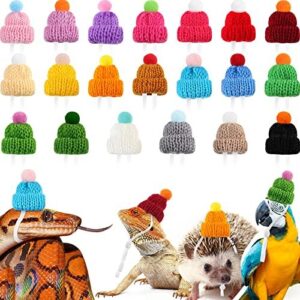
Curious about adding a dash of personality to your habitat setup? Mini Reptile Snake Hat Accessories Sets lead the pack in style trends without overlooking hat safety, size suitability, or material durability.
Each set usually offers up to 20 lightweight, adjustable hats—fitting most small to medium snake breeds with ease. Customer reviews consistently highlight their comfort and variety, and the low accessory expenses (often under $8 per set) make them a simple, practical upgrade for your enclosure setup and habitat accessory collection.
Best For: Pet owners who want to dress up their small reptiles for photos, themed events, or just some extra cuteness at home.
- Wide variety of colors and designs lets you easily switch up your pet’s style.
- Lightweight, adjustable hats designed for comfort, so most snakes tolerate them well.
- Bundle packs are affordable and ideal for multi-pet households.
- Sizing may be hit-or-miss for very small or unusually shaped species.
- Quality can be inconsistent, with some hats arriving stitched closed or imperfectly finished.
- Colors may appear different in person due to screen differences or dye batches.
2. Mini Pet Hats Cute Animal Decor
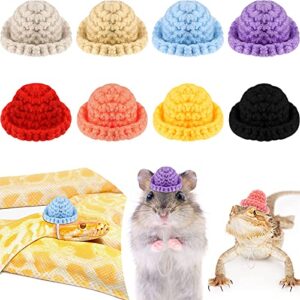
Looking for an easy mood boost with minimal pet expense? Mini Pet Hats Cute Animal Decor brings a touch of whimsy without blowing your Snake Habitat Setup Cost budget.
Each hat is crafted from soft, non-toxic materials with an adjustable strap, making hat safety and proper fit top priorities. These hats are best suited for short, supervised photo opportunities—limit usage duration to 30 minutes.
Sizing concerns do pop up, so double-check dimensions to avoid disappointment. Fun, practical, and surprisingly affordable accessory expenses.
Best For: Pet owners who want a playful way to dress up and photograph their small snakes or reptiles for social media or special occasions.
- Cute, colorful designs bring out personality in photos.
- Easy to put on and adjust with the elastic strap.
- Affordable way to join the latest pet accessory trend.
- May not fit larger snakes or reptiles.
- Some hats might not stay on if your pet is wiggly.
- Only meant for short, supervised use to keep pets safe.
3. Adjustable Snake Crown for Ball Python
Ever wonder if your Ball Python could rock a crown? Adjustable snake crowns are the breakout star among habitat decor, balancing Crown safety with Material durability. Constructed from soft, non-toxic fabrics and elastic, these playful accessories make every photo op shine.
Market trends show a surge in decorative wearables, with Consumer feedback highlighting secure fit and comfort. Importantly, Health impacts are minimal when used properly—limit wear to brief, supervised sessions inside the Snake enclosure where Heating systems and Thermostat regulation won’t interfere with Humidity control.
Best For: Snake owners who want unique, safe, and camera-ready accessories for special moments with their ball pythons.
- Easy to adjust for a secure and comfortable fit.
- Durable and made from non-toxic, reptile-safe materials.
- Top-rated for decorative flair and great for fun photo shoots.
- May be too large or heavy for smaller or more active snakes.
- Not all snakes tolerate wearing accessories, even for short supervised use.
- Needs to be used with care to avoid accidental snagging or stress.
4. Zilla Shed Ease Reptile Bath
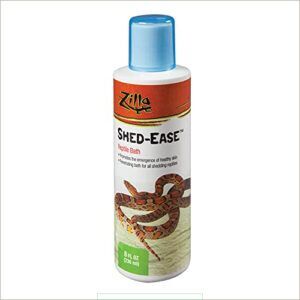
Right after snapping a photo of your snake in its crown, shed problems can sneak up. The Zilla Shed Ease Reptile Bath is a proven ally for shedding assistance.
Its aloe-infused formula soothes scales, supporting snakes from pythons to corn snakes. Simple Bath Dosage instructions—10 ml per 16 oz water—make it species-compatible and safe to use.
With prices hovering between $8 and $20, it’s an affordable solution when you weigh the bigger picture of snake care expenses and long-term snake ownership costs.
Best For: Reptile owners—especially those with snakes or lizards prone to stuck sheds or dry skin—wanting a gentle, reliable soak to ease shedding.
- Soothes skin with aloe vera and helps remove tough or stuck sheds.
- Simple to use and suitable for all types of snakes and lizards.
- Affordable price and widely available at pet stores and online.
- Must be diluted and used as a bath, not a quick spray.
- Not a fix for medical or infectious skin problems.
- Requires close supervision during use and careful dosage.
5. Pet Lou Green Jungle Snake Toy
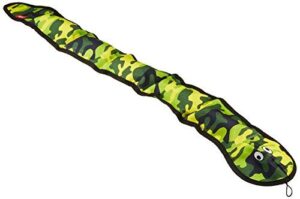
Let’s talk enrichment. The Pet Lou Green Jungle Snake Toy isn’t just for dogs—its sturdy, stuffingless plush body and double-stitched seams make it a favorite among pet keepers who care about Toy Safety and Material Durability.
Rated 5 stars in recent Customer Ratings, this squeaky, crinkly toy averages $19.99, often selling out thanks to its enrichment value in both snake and dog habitats.
Factoring cost analysis and snake care expenses, it’s a strong contender for affordable habitat setup costs.
Best For: Pet parents who want a safe, extra-durable, enrichment toy for large dogs or snakes and don’t mind paying for long-lasting quality.
- Safe, double-stitched plush design with no small parts for peace of mind.
- Loved by users, with a perfect 5-star customer rating and proven enrichment benefits for both canine and reptile habitats.
- Washable, stuffingless, and features squeaker plus crinkle sounds for added interactive play.
- Not indestructible—aggressive chewers or destructive dogs may still tear it apart with heavy use.
- Squeakers might stop working quickly if played with intensely.
- Often sells out during holidays and busy seasons, so availability can be an issue.
6. Zoo Med Aspen Snake Bedding
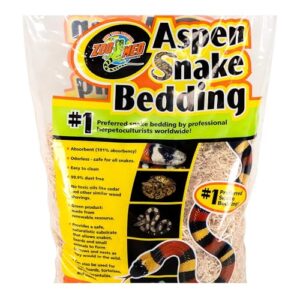
After play comes rest—and for that, Zoo Med Aspen Snake Bedding stands out in any snake habitat setup. Known for its Aspen absorbency and 99.9% low dust content, it addresses messes while lowering risks for scale and skin issues.
Spot cleaning weekly and a full change every 4–8 weeks means easy maintenance, balancing cleaning frequency and cost analysis.
This substrate suits burrowing species especially well, making it a reliable staple for both snakes and discerning keepers eyeing efficiency and value.
Best For: Keepers of burrowing snakes and reptiles who want easy spot cleaning and care, plus reliable comfort for sensitive pets.
- 99.9% dust-free and hypoallergenic, great for pet and owner health
- Superb absorbency keeps odors in check and habitat dry
- Allows for natural burrowing and tunnel making
- Can be a bit dusty when first poured in
- Needs a full change every 4–8 weeks for best results
- Wet bedding won’t always dry out fully if soaked
7. Sphynx Cat Summer Snake Shirt
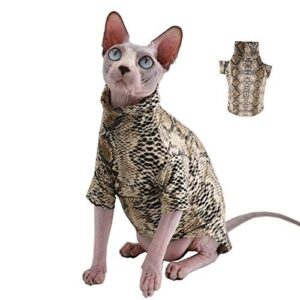
Just as Aspen bedding makes things comfortable below, a Sphynx Cat Summer Snake Shirt protects your hairless cat above—especially during habitat setup when heating systems need adjustment.
These shirts use fabric breathability and UV protection to guard against sun or cold, mirroring the care you give your snake enclosure.
Designed with Sizing Accuracy and washing durability in mind, their eye-catching prints reflect current design trends and help manage maintenance costs, keeping both your snake and feline companions in tip-top shape.
Best For: Hairless cat owners looking to keep their Sphynx comfortable and stylish year-round with easy-care, breathable, and protective apparel.
- Soft, hypoallergenic cotton protects sensitive Sphynx skin from sunburn and chills.
- Fun snake-skin design is trendy and perfect for social media photos or special occasions.
- Machine washable and durable, making daily use and cleaning convenient.
- Sizing is tailored for hairless cats; may not fit other breeds without careful measuring.
- Some cats may not like wearing clothing, so it may take time for them to adjust.
- Fabric can stretch or tear with rough play, so durability may vary over time.
8. Bearded Dragon Cowboy Hat Bandana Set
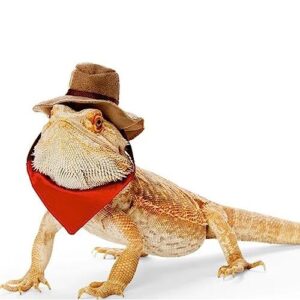
Nothing breaks the ice at a herp meet quite like a bearded dragon in a cowboy hat and bandana. Costume safety and reptile comfort are clearly prioritized here—adjustable, soft fabric avoids stress during use.
The surge in usage trends for these accessories reflects both social media influence and steady market growth in 2024. Still, ethical considerations matter: short wear times and proper age guarantee safety, making this a lighthearted yet practical add-on alongside essential enclosure upgrades and your ongoing habitat setup cost.
Best For: Reptile owners who want a fun, easy accessory for photos, parties, or pet events, especially with social media in mind.
- Adjustable and comfortable fit for most bearded dragons or small reptiles
- Soft, pet-safe fabrics and easy-to-remove design for quick use
- Highly rated for social media photos and as a unique gift
- Fit may be off for some pets or not exactly as pictured
- Some buyers found it pricey for a novelty accessory
- Not suitable for very young reptiles or extended wear
9. ECOFLEX Mojave 36 Inch Reptile Lounge
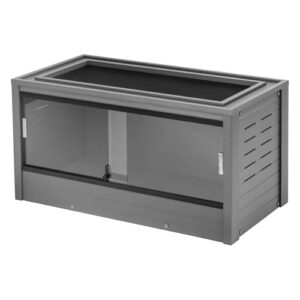
A mid-range standout in any snake habitat setup, the ECOFLEX Mojave 36 Inch Reptile Lounge brings durability and ease of assembly to your enclosure lineup.
ECOFLEX material resists odor and moisture, while a thoughtful ventilation design promotes healthy airflow. At $250–$300, it offers solid value in cost comparison with pricier PVC options.
The front sliding glass doors make cleaning less of a headache, though some user modifications—like cable ports—help tailor the snake enclosure. It fits most medium species and typical habitat setup cost budgets.
Best For: Reptile keepers wanting a sturdy, easy-to-clean mid-sized terrarium with good airflow and modern looks.
- Durable ECOFLEX build resists moisture and odors for healthier pet living.
- Front sliding glass doors and mesh top make access and cleaning easy.
- Quick tool-free assembly and a 10-year warranty for long-term peace of mind.
- Not watertight—extra sealing is needed for high-humidity habitats.
- Mesh top and lack of cord ports may require modifications.
- ECOFLEX panels aren’t chew-proof and deep front glass can limit pet visibility.
10. Simple Deluxe Ceramic Heat Emitter
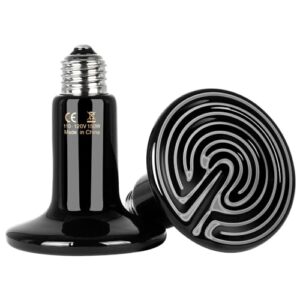
A reliable heat source, the Simple Deluxe Ceramic Heat Emitter stands out for its superb heating efficiency and thoughtful safety features. This 150W ceramic bulb delivers stable warmth without light, supporting your snake’s rhythm.
Paired with a quality thermostat, it maintains ideal enclosure temps. Cost analysis is favorable—a two-pack runs under $36, and the claimed bulb lifespan tops 10,000 hours.
Customer reviews highlight long-term value and compatibility with standard reptile heating systems, making it a practical upgrade over a basic heating pad.
Best For: Reptile and amphibian keepers who need a reliable, light-free heat source that helps maintain stable overnight temperatures.
- Heats efficiently and doesn’t disturb animals’ sleep since there’s no light.
- Durable, long-lasting bulb with a lifespan up to 10,000 hours.
- Works with standard porcelain E26 sockets and most thermostat controllers.
- Gets extremely hot and requires careful placement and a protective guard.
- Needs a separate thermostat for precise temperature control.
- Not suitable for use in damp or wet enclosures.
Frequently Asked Questions (FAQs)
How do you choose a snake enclosure?
Size matters more than most realize—aim for an enclosure size that lets your snake stretch and explore.
Weigh enclosure material, ventilation needs, security features, and your budget considerations before purchasing any reptile enclosure or snake habitat kit.
How often should snake habitat decor be replaced?
Imagine decor as the furniture of your snake’s world: Replace enrichment features each year, or sooner if Material Degradation, Bacteria Buildup, or cleaning frequency signals trouble.
Swapping out old gear on schedule isn’t just about looks—it helps you spot problems early, keeps costs down, and gives your snake a safe, fresh home.
How much does a snake vet cost?
Snake veterinary bills can feel steep, with routine exotic vet fees usually $100-$200, while emergency vet costs easily top $
Insurance can help take the edge off, but skipping the vet and trying to treat your snake at home often backfires—leaving you with surprises that cost more in the long run.
How do I create a safe home for my scaly snake?
How gently do you cradle a secret? That’s what a scaly snake expects: a safe enclosure design with escape-proof locks, secure hiding, balanced temperature regulation, humidity control, proper substrate, and daily enrichment options—essential foundations for thriving.
How do you care for a snake’s enclosure?
Consistently caring for your snake’s enclosure means regular enclosure cleaning, monitoring substrate, keeping humidity control steady, and maintaining proper temperature gradients.
Prioritize airflow and ventilation needs, prevent mold, and add health monitoring so your snake thrives.
How do I get started taking care of snakes?
“Measure twice, cut once”—how do you lay the groundwork for snake care? Begin with initial research on species selection, learn enclosure basics and care techniques, and focus on basic husbandry for successful, low-stress snake habitat setup and maintenance.
How much does snake habitat insurance cost?
Ever thought about covering unexpected veterinary bills? Snake insurance, or exotic pet insurance, ranges from $10 to $30 monthly.
Policy cost factors include species risk assessment and whether you want coverage for medical expenses or broader veterinary care.
What are costs for pest prevention in enclosures?
Ever wondered what you’re really paying for with pest prevention? Mite prevention costs and substrate pest control run $20–$50 annually, with disinfectant price points at $8–$15, plus quarantine tank expenses, cleaning supplies, and routine preventative vet care.
How expensive is to relocate a large setup?
When you tackle Relocation Planning for a large enclosure, expect Packing Materials, Transportation Costs, Setup Insurance, plus Post-Move Adjustments to add up quickly.
Factoring Equipment replacement and Habitat maintenance makes the total cost of pet ownership unpredictable.
Are there added fees for exotic snake permits?
Depending where you live, Permit Costs for keeping Exotic Species can add a surprising turn to your pet expenses.
Legality Issues, Permit Requirements, and the Application Process are real factors to keep in mind when budgeting for snake species costs.
Conclusion
Savvy snake stewards smartly study every snake habitat setup cost breakdown before diving in. Planning for the tank, heating, lighting, and ongoing care leads to a smoother, safer journey for your slithery sidekick.
Matching equipment and expenses to your reptile’s needs helps prevent surprises down the road. With careful budgeting and research, you can create a secure, stimulating home that bolsters your snake’s health and happiness for years to come.
Choose wisely—and enjoy the adventure.
- https://www.stumpscustomwood.com/keeping-up/diy-pvc-reptile-enclosure-build-guide-costs
- https://www.xyzreptiles.com/how-much-is-a-pet-snake/
- https://www.reddit.com/r/ballpython/comments/1blh6jz/owners_who_built_their_own_enclosure_was_it_more/
- https://exoticdirect.co.uk/news/corn-snake-setup-costs/
- https://www.youtube.com/watch?v=oQ7Q3XiA5Xw

